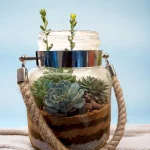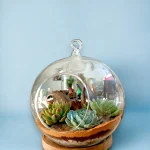Closed vs Open Terrariums - Choosing the Right Fit
Terrariums bring nature indoors, customizable for any space, either closed or open terrariums. But what sets them apart? Let’s start this debate on closed vs open terrariums.
Differences Between Closed vs Open Terrariums:
Closed terrariums, entirely sealed, require minimal maintenance, making them an excellent choice for those who seek a green haven without the need for constant watering or misting.
In contrast, open terrariums, lacking a seal, demand more attention. Regular watering and misting are necessary, and careful monitoring is essential to prevent excessive wetness or dryness. Open terrariums are better suited for individuals with the time and patience to consistently care for their plants.
Plant Requirements:
Various plants have distinct needs regarding light, water, and air for optimal growth. Hence, selecting the appropriate terrarium type is crucial. Closed terrariums suit plants craving high humidity and minimal airflow, whereas open terrariums are more suitable for plants requiring increased airflow and less humidity.
Drainage Layer Variations:
In the comparison of closed terrariums versus open terrariums, a notable distinction lies in the required drainage layer. Closed terrariums necessitate a layer of gravel or charcoal to aid drainage, whereas open terrariums demand pebbles, soil, charcoal, and rocks. This divergence is attributed to the fact that closed terrariums depend on condensation to establish a humid environment, necessitating a drainage layer to preventsoil saturation.
Terrarium care
Closed Terrariums:
In closed terrariums, plants create a microclimate, minimizing maintenance compared to open ones. While excelling in humidity control, they can overheat, necessitating careful monitoring and ventilation.
Open Terrariums:
With superior airflow, open terrariums prevent fungal diseases and suit hot climates. However, more frequent watering makes them less ideal for plants requiring high humidity. Choose based on your plant’s needs and environmental conditions.
Benefits of closed vs open Terrarium
Benefits of Open Terrariums:
Open terrariums offer several advantages compared to closed terrariums:
- Improved Airflow: Better airflow helps prevent the development of mold and mildew.
- Moisture Monitoring: Easier monitoring of soil moisture levels, reducing the risk of over-watering.
- Enhanced Light Exposure: Allows for more light exposure, promoting healthier plant growth.
Benefits of Closed Terrariums:
Closed terrariums provide unique benefits, creating a miniature ecosystem:
- Moisture and Humidity Control: By sealing in moisture and humidity, closed terrariums create an ideal environment for plant thriving.
- Self-Containment: Closed terrariums are self-contained, eliminating the need for frequent watering and preventing outside air infiltration.
- Air Purification: Closed terrariums aid in purifying indoor air by trapping pollutants. Plants naturally absorb toxins, contributing to improved air quality and easier breathing






Closed terrariums are suitable for plants with high humidity needs, whereas open terrariums are ideal for plants requiring increased air circulation. This is a ultimate guide on closed vs open terrariums. If you’re uncertain about the right terrarium feel free to reach out to us when ordering online.

